If you’re experiencing a sensation of catching or locking when you straighten or bend your fingers or thumb, you may be dealing with Trigger Finger. Trigger finger, commonly known as stenosing tenosynovitis, is a condition that affects the tendons in your fingers, causing pain, stiffness, and a popping or clicking sensation when you try to move your finger. It occurs when the sheath that surrounds the tendon in your finger becomes inflamed or swollen, making it difficult for the tendon to glide smoothly through the sheath.
As a result, your finger may become stuck in a bent position and then suddenly snap straight, like a trigger being pulled and released. If left untreated, trigger finger can lead to more severe symptoms and complications, including loss of grip strength and decreased range of motion in the affected finger. However, with proper treatment and care, most people with trigger finger are able to recover and resume their normal daily activities.
Thankfully, Dr Stuart Kirkham from the Sydney Orthopaedic Surgeon Clinic has had years of experience in treating patients with trigger finger. We always tailor our treatment options to suit your specific needs, because regardless of whether you are experiencing mild sporadic pain or chronic ongoing pain, Dr Stuart Kirkham is here to help. We understand the impact that trigger finger can have on your quality of life and our goal is to help you with treatment options so you can regain the use of your hand as quickly and safely as possible. Dr Stuart Kirkham can assist you whether you need conservative treatment such as injections or therapy, or surgical intervention.
Anatomy
Trigger finger is a condition that affects the tendons in the hand, specifically the tendons that control the movement of the fingers and thumb. In order to understand how trigger finger occurs, it’s helpful to first understand the anatomy of the hand.
The fingers are made up of three bones called phalanges, except for the thumb, which has two. These bones are connected by joints and moved by muscles and tendons. Tendons are strong, fibrous tissues that attach muscles to bones. In the hand, the muscles that control finger and thumb movement are located in the forearm.
Tendons in the hand are covered by a protective layer of tissue called the synovium. The synovium produces synovial fluid, which helps lubricate the tendons and reduce friction as they move through the narrow spaces between the bones and surrounding tissues.
When the tendons in the hand become irritated or inflamed, the synovium can thicken and swell, making it difficult for the tendons to move smoothly through the sheath. This can result in pain, stiffness, and difficulty moving the affected finger or thumb.
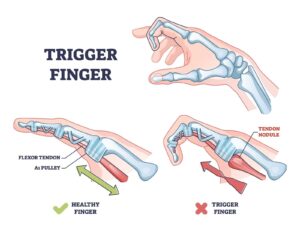
Understanding the Anatomy of Trigger Finger
In the case of trigger finger, the tendon that controls the movement of a finger or thumb becomes inflamed and swollen, causing it to get stuck in the sheath. When the finger or thumb is straightened, the tendon can’t move through the sheath, causing it to catch or lock in place before suddenly releasing, like a trigger being pulled and released.
The most commonly affected tendons in trigger finger are those that control the movement of the ring finger and thumb. This condition is more common in women than men and is often seen in people who perform repetitive gripping or grasping motions, such as musicians, factory workers, or those who use hand-held tools.
Causes of Trigger Finger
Trigger finger is a condition that does not have a specific cause, although there are several risk factors and conditions that may contribute to its development. Risk factors for developing trigger finger include age, gender, and certain medical conditions. Trigger finger is more common in people over the age of 40, with women more likely to develop the condition than men. People with medical conditions such as diabetes, rheumatoid arthritis, and hypothyroidism are also at increased risk of developing the condition.
Some activities such as repetitive gripping or grasping activities may contribute to the development of trigger finger. For instance, playing a musical instrument, using tools, or typing on a computer keyboard for long periods of time.
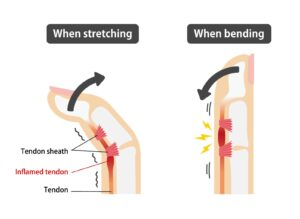
Understanding the Causes of Trigger Finger
In some cases, trigger finger may develop due to an injury or trauma to the hand or fingers such as a fracture, dislocation, or sprain, as well as overuse injuries such as tendinitis or bursitis. Specific medications such as estrogen therapy or chemotherapy drugs have also been linked to an increased risk of developing trigger finger.
It’s important to note that while these risk factors and conditions may contribute to the development of trigger finger, not everyone who experiences them will develop the condition. If you are experiencing symptoms of trigger finger, it’s important to talk to your doctor and get a referral to Dr Stuart Kirkham to determine the underlying cause and develop an appropriate treatment plan that meets your needs.
Symptoms of Trigger Finger
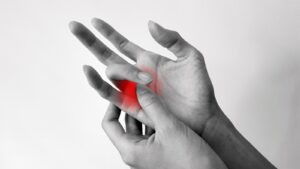
Recognizing Trigger Finger Symptoms: Causes, Treatment and Prevention
The symptoms of trigger finger can vary from person to person, but they generally involve pain, stiffness, and a popping or clicking sensation when you try to move your finger. Here are some of the common symptoms of trigger finger:
- Pain or tenderness in the affected finger or thumb
- Stiffness or a feeling of tightness in the affected finger or thumb
- A popping or clicking sensation when you try to move the affected finger or thumb
- Difficulty straightening or bending the affected finger or thumb
- A bump or nodule on the affected finger or thumb
- A feeling of locking or catching in the affected finger or thumb
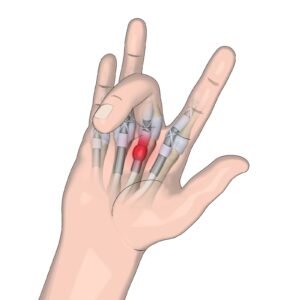
Recognizing Trigger Finger Symptoms
These symptoms can range from mild to severe, and they may come and go or be constant. In some cases, people notice that the symptoms of trigger finger may be worse in the morning or after periods of inactivity.
Trigger finger can have a significant impact on your daily life, particularly if it affects your dominant hand or fingers. The pain and stiffness associated with the condition can make it difficult to perform simple tasks such as typing, writing, or grasping objects. As well as this, you may also experience difficulty with more complex tasks such as playing a musical instrument or participating in sports.
Over time, the limited mobility and pain associated with trigger finger can lead to decreased grip strength and a decreased range of motion in the affected finger or thumb. This can make it even more difficult to perform daily activities and can significantly impact your quality of life.
If you are experiencing symptoms of trigger finger, it’s important to talk to Dr Stuart Kirkham at the Sydney Orthopaedic Surgeon Clinic to determine the underlying causes and develop an appropriate treatment plan. With proper care and treatment, most people with trigger finger are able to recover and resume their normal daily activities.
Diagnosis of Trigger Finger

Diagnosing Trigger Finger: Understanding the Symptoms and Causes
If you are encountering indications of trigger finger, the first step is to reach out to your doctor and receive a referral to the Sydney Orthopaedic Surgeon Clinic. Dr Stuart Kirkham will perform a thorough analysis, including a physical examination of your hand and fingers to check for signs of inflammation, stiffness, or a popping or clicking sensation. As well as this, we will cover your medical history and any activities that may have contributed to the development of the condition.
Occasionally, imaging tests such as an ultrasound or x-ray may be required to rule out other conditions that may be causing your symptoms. However, in most cases, a diagnosis of trigger finger can be made based on a physical examination and a review of your medical history.
If you are experiencing the symptoms of trigger finger, particularly if they are severe or are affecting your daily activities, speaking to Dr Stuart Kirkham will assist you in receiving an early diagnosis. Treatment for trigger finger can help to prevent further damage to your hand and fingers and can improve your chances of a full recovery.
Treatment Options for Trigger Finger
If you have been diagnosed with trigger finger, Dr Stuart Kirkham will work with you to develop an appropriate treatment plan based on the severity of your symptoms and the underlying cause of the condition. Treatment options for trigger finger can include conservative measures, medical treatment, and surgical intervention.
Conservative measures for trigger finger typically involve resting the affected hand and avoiding activities that exacerbate your symptoms. You may receive the recommendation to wear a splint or brace as a way to immobilise the affected finger or thumb, and you may also be provided with gentle exercises to improve flexibility and reduce stiffness. In addition, over-the-counter pain medications such as acetaminophen or nonsteroidal anti-inflammatory drugs (NSAIDs) may be recommended to help manage pain and inflammation.
If conservative measures are not effective in relieving your symptoms and pain levels, further medical treatment may be recommended to treat your condition. Medical treatment may include corticosteroid injections, which can help to reduce inflammation and alleviate symptoms. In some cases, a hand therapy regime may be recommended to help improve your range of motion and reduce pain.

Relief for Trigger Finger: Effective Treatment Options
If conservative and medical treatments are not effective, surgical treatment may be recommended to treat trigger finger. Surgical treatment may involve a procedure known as a trigger finger release, which involves releasing the A1 pulley, which is the pulley that causes the constriction of the affected finger or thumb. After this has been released, the flexor tendon will be able to move and glide easily in the tendon shaft. In most cases, this surgery may be performed using minimally invasive techniques, which can result in less scarring and a faster recovery time. Dr Stuart Kirkham will work with you to determine the best treatment approach for your individual needs.
Don’t let the symptoms of trigger finger impact your day-to-day life. Contact the Sydney Orthopaedic Surgeon Clinic today to schedule an appointment to gain the best treatment options for you.
Prevention of Trigger Finger
While the exact cause of trigger finger is not fully understood, there are certain approaches that may help to reduce your risk of developing the condition. By taking the available steps to prevent the development of trigger finger, you can help to protect your hand and finger health and reduce your risk of developing this painful and debilitating condition.
The most common approaches for preventing trigger finger include:
- Taking breaks: If you engage in repetitive activities that involve repetitive gripping or grasping of objects, take frequent breaks to rest your hands and fingers. This can help to reduce strain and prevent overuse injuries.
- Stretch and strengthen: Regularly stretching and strengthening your hands and fingers can help to improve flexibility and reduce stiffness. It may be beneficial to consider incorporating hand and finger exercises into your daily routine to help keep your hands healthy and strong.
- Maintaining a healthy weight: Excess weight can put additional strain on your hands and fingers, increasing your risk of developing trigger finger. By maintaining a healthy weight through a balanced diet and regular exercise, you can help to protect your hand and finger health.
- Wearing protective gear: If you engage in activities that put your hands and fingers at risk of injury, such as gardening or DIY projects, wearing appropriate protective gear such as gloves will assist in reducing your risk of injury.
- Treatment of underlying conditions: Certain underlying medical conditions, such as diabetes or arthritis, can increase your risk of developing trigger finger. By properly managing these conditions through medication, lifestyle changes, or other treatments, you can help to reduce your risk of developing trigger finger.
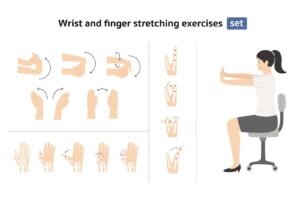
Preventing Trigger Finger: Tips for Healthy Hands
By incorporating these strategies into your daily routine, you can help to protect your hand and finger health and reduce your risk of developing trigger finger. However, if you do experience symptoms of trigger finger, it’s important to speak to Dr Stuart Kirkham for an accurate diagnosis and appropriate treatment. With proper care and treatment, most people with trigger finger are able to quickly recover.
Recovery from Trigger Finger
Recovery from trigger finger depends on the severity of your symptoms and the type of treatment you receive. With proper care and treatment, most people with trigger finger are able to recover and resume their normal daily activities.
The timeline for recovery from trigger finger varies depending on the severity of the condition and the type of treatment received. In cases where conservative measures such as rest and immobilisation are effective, recovery may occur within a few weeks. Medical treatment such as corticosteroid injections may require several weeks to take full effect, while surgical intervention may require a longer recovery period. In most cases, the incision should heal within 4-6 weeks, although it may take 4-6 months for the stiffness and swelling to completely subside.
Tips for recovering from trigger finger:
- Follow your doctor’s recommendations: It’s essential to follow your doctor’s advice for treatment and recovery to ensure the best possible outcome. This may include rest, immobilisation, physical therapy, or other treatments.
- Avoid activities that exacerbate symptoms: While recovering from trigger finger, avoiding activities that exacerbate your symptoms is important. This may include avoiding repetitive motions or tasks that require gripping or grasping objects.
- Use pain management strategies: If you experience pain during recovery, talking to Dr Stuart Kirkham about pain management strategies such as over-the-counter pain medications or physical therapy may assist in your recovery.
- Gradually resume activities: As your symptoms improve and your recovery progresses, gradually resume your normal daily activities. Start with low-impact activities and gradually increase the intensity and duration of your activities as tolerated.
- Follow up with your doctor: It’s essential to follow up with your doctor regularly to monitor your progress and ensure that your recovery is on track.
 Healing your hands: Understanding Trigger Finger RecoveryBy following these tips and working closely with the team at the Sydney Orthopaedic Surgeon Clinic, you can help to ensure a successful recovery from trigger finger and return to your normal daily activities as quickly and safely as possible.
Healing your hands: Understanding Trigger Finger RecoveryBy following these tips and working closely with the team at the Sydney Orthopaedic Surgeon Clinic, you can help to ensure a successful recovery from trigger finger and return to your normal daily activities as quickly and safely as possible.
Possible Complications of Trigger Finger
In most cases, trigger finger is a treatable condition with a good prognosis. However, there are potential complications that can arise if the condition is left untreated or if there are complications with treatment.
- Stiffness: If trigger finger is left untreated or if the condition is severe, it can lead to stiffness in the affected finger or thumb. This can make it difficult to perform everyday tasks such as grasping objects or typing on a keyboard.
- Reduced range of motion: If trigger finger is left untreated for an extended period of time, it can lead to a reduced range of motion in the affected finger or thumb. This can make it difficult to perform certain activities or tasks.
- Inability to straighten the affected finger: In rare cases, trigger finger can progress to a point where the affected finger or thumb becomes permanently bent or unable to straighten.
- Infection: Any time the skin is broken, there is a risk of infection. In cases where surgery is necessary to treat trigger finger, there is a risk of infection at the surgical site.

Understanding Trigger Finger Complications: Symptoms, Treatment, and Prevention
If you experience any of the following complications, it’s important to seek medical attention.
- Persistent pain or swelling in the affected finger or thumb
- Inability to move or straighten the affected finger or thumb
- If you have had surgery for trigger finger, any signs of infection such as redness, warmth, or pus at the surgical site
- Any other symptoms or complications that cause concern
If you experience any of these issues, seek medical attention immediately to prevent further damage and ensure the best possible outcome. By being aware of the potential complications of trigger finger and seeking prompt medical attention if necessary, you can help to minimise the risk of long-term damage and ensure a successful outcome.
Are you concerned about the possible complications of trigger finger? Contact the Sydney Orthopaedic Surgeon Clinic today to speak to our expert and put your worries at ease.
FAQs
- How long does recovery take after surgery for trigger finger?
Recovery after trigger finger surgery is dependent on the individual. In most cases, the symptom of triggering will have disappeared before the procedure is finished. Most patients will have either full range or close to full range on day one. In cases where surgical treatment has been used, the incision on the surgical site generally heals within a couple of weeks. We usually take out the two or three stitches at day 14.
The return to work period once undergoing trigger finger surgery is dependent on the patient’s occupation. As a guide, most people return to work within 2 weeks after their surgery. Office workers often return within 1-2 days and manual workers often require 3 or 4 weeks. In the recovery process, it is important to follow the recommendations from the medical team to recover as soon as possible. If you have any concerns about your recovery process, Dr Stuart Kirkham will be happy to assist you.
2. How effective is trigger finger treatment?
For some people, non-surgical treatment is not required in their treatment plan as conservative measures such as exercises alongside other medical treatments such as injections significantly reduce their symptoms. In the cases of conservative and some medical treatments, recovery can occur within a few weeks.
Although recovery from surgical intervention for trigger finger may take longer for a full recovery, surgical treatment has been demonstrated to be highly effective in trigger finger treatment. Fortunately, the majority of people who undergo surgical treatment to treat trigger finger experience a significant improvement in their symptoms relating to pain and stiffness alongside an improvement in their function.
3. What might happen if I don’t receive treatment for trigger finger?
If trigger finger is left untreated, it can lead to a range of complications. For starters, the affected finger or thumb may become permanently locked in a bent or straight position, making it difficult to perform everyday tasks. Over time, this can cause discomfort and pain, and limit your ability to use your hand.
Untreated trigger finger can also result in the formation of a nodule or bump at the base of the affected finger, which can make it even more difficult to move. This bump can also be tender and sensitive to the touch, making it uncomfortable to perform even simple activities like typing on a keyboard or holding a cup When trigger finger is left untreated it can affect other fingers or thumbs, leading to the development of multiple trigger fingers, which can make it challenging to use your hand for any activity, and greatly impact your quality of life.
4. Is there anything that makes trigger finger worse?
Certain activities or conditions can make trigger finger worse or increase your risk of developing it. For instance, repeatedly gripping or grasping objects for long periods of time can put strain on your finger tendons and increase your chances of developing trigger finger.
Medical conditions such as rheumatoid arthritis, diabetes, or hypothyroidism can also make you more susceptible to developing trigger finger. In some cases, injury or trauma to the hand can also trigger the condition. In particular, direct injury to the palm or fingers can cause inflammation of the tendon sheaths, leading to the development of trigger finger.
Repetitive motions, such as typing or using a mouse for long periods, can also contribute to the development or worsening of trigger finger. It is important to note that if you are experiencing symptoms of trigger finger, it is best to avoid activities that may aggravate the condition until you have received proper treatment.
5. Is trigger finger related to arthritis?
Trigger finger can be associated with certain types of arthritis, particularly rheumatoid arthritis. Rheumatoid arthritis is a chronic autoimmune disorder that can affect the joints and tendons throughout the body, including those in the fingers and hands. In fact, people with rheumatoid arthritis are more likely to develop trigger finger than those without the condition.
The link between trigger finger and arthritis is due to the inflammation and swelling that can occur in the tendons and joints affected by arthritis. This inflammation can cause the tendon sheaths to thicken, making it difficult for the tendons to move smoothly through them. As a result, the tendons can become irritated and inflamed, leading to the development of trigger finger.
However, it is important to note that not all cases of trigger finger are related to arthritis. Trigger finger can also be caused by repetitive hand movements, overuse of the hand or fingers, or injury to the hand or fingers.
References
- American Academy of Orthopaedic Surgeons. (Trigger Fingers)
- American Society for Surgery of the Hand. (Trigger Finger)
- Health Direct. (Trigger Finger Release)
- NI Direct. (Trigger Finger)


